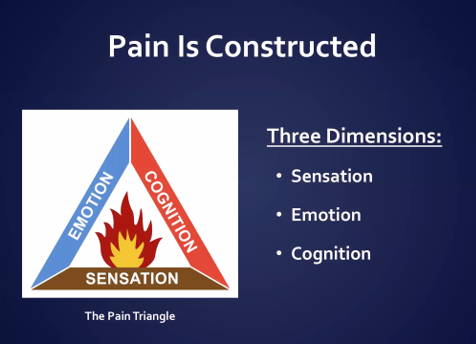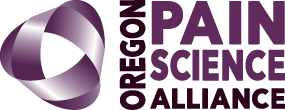- International Association for the Study of Pain (IASP):
Pain is “An unpleasant sensory and emotional experience associated with actual or potential tissue damage, or described in terms of such damage.”
- Dr. Kevin Cuccaro, D.O.:
THE PAIN TRIANGLE

MASTERY CONCEPT #1: PAIN = PROTECTION
Pain cannot be explained by bodily damage. The person’s perceived danger is the key to their pain.
MASTERY CONCEPT #2: All Pain comes from the Brain (not from the Body).
Pain is a dynamic process constructed in the brain from three elements imagined as a triangle: (1) cognitive/evaluative (HEAT), (2) affective/ motivational (OXYGEN), and (3) sensory/discriminative (FUEL). Just as fire fighters understand that a fire burns only in the presence of heat, oxygen, and fuel, the Pain Triangle’s three elements are the combined source of pain. Firefighters put out fires by eliminating oxygen, heat, or fuel. Likewise, people experiencing pain can use their understanding of the Pain Triangle to “deconstruct” their pain fire. They master their pain by dealing with its cognitive, sensory, and/or emotional aspects.
MASTERY CONCEPT #3: If you understand what you are treating, you can treat it.
Risk factors for pain, anxiety, depression, substance abuse are all the same.
Strong belief that pain = damage creates increased pain.
Endorphins are our body’s natural opioid system, so if a person takes opioids their reactivity to threat (i.e. their pain) increases.
- Lorimer Moseley, DSc, PhD, FACP and David S. Butler BPhty MAppSc EdD
THE GRAND POOBAH PAIN THEORY (GPPT)
- Pain is an unpleasant feeling that is felt somewhere in the body and urges us to protect that bodily location.
- Pain is one of many protective mechanisms. Others include movement, immune, cognitive, endocrine and autonomic.
- Pain is the only protective mechanism we are necessarily aware of and compels us to do something to protect the painful bit.
- Pain is modulated by any credible evidence that protection is warranted.

